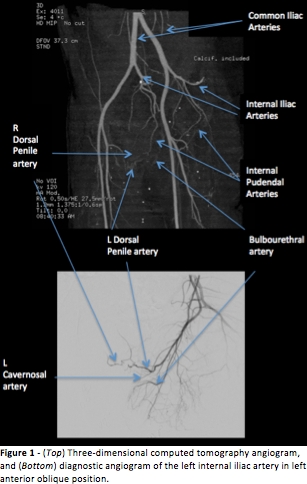Planning Genitourinary Vascularized Composite Allotransplantation: A Pre-Operative Imaging Protocol.
Massachusetts General Hospital, Boston, MA.
Meeting: 2016 American Transplant Congress
Abstract number: A87
Keywords: Angiography, Magnetic resonance imaging, Radiologic assessment
Session Information
Session Name: Poster Session A: Clinical Vascularized Composite Allotransplantation
Session Type: Poster Session
Date: Saturday, June 11, 2016
Session Time: 5:30pm-7:30pm
 Presentation Time: 5:30pm-7:30pm
Presentation Time: 5:30pm-7:30pm
Location: Halls C&D
Study purpose: To define the ideal pre-operative imaging protocol necessary for proper planning of a genitourinary vascularised composite allotransplantation (GUVCA) procedure.
Methods: The multidisciplinary GUVCA team at our study center constituted a preoperative genital imaging protocol using an example case, including high resolution computed tomography angiography (CTA), pelvic and penile magnetic resonance imaging (MRI), and diagnostic angiography. Cadaveric dissections were performed to design novel genitourinary composite donor flaps and help optimize the imaging protocol. The example patient had previous total penectomy after sustaining 70% total body surface area burns.
Results: Anatomic dissections illustrated all penile arteries branching off the internal pudendal artery, and donor VCAs were procured with internal pudendal and bulbar arteries intact. Using MRI, preferably with isometric high-resolution sequences, identification of neural bundles alongside the internal pudendal artery was allowed to at least the region immediately posterior to the pubic symphysis. MRI with contrast indicated corporal viability. CTA technique can be used for volumetric and multiplanar analysis of arterial vasculature critical for pre-operative planning. Diagnostic angiography held continued advantage over CTA in situations with suboptimal characterization of smaller vessels, e.g. dorsal penile arteries. 
Conclusions: For good function of a genitourinary allograft, adequate knowledge of the neurovascular bundles with high-resolution anatomic detail is needed. It allows for screening eligibility of patients, enables surgeons to plan for the best approach, and potentially determines post-operative prognosis.The preoperative imaging protocol presented in this study represents an essential roadmap to effective surgical planning and likely improves success for future GUVCA patients.
CITATION INFORMATION: Schol I, Drijkoningen T, Choy G, Liu R, Tanrikut C, Holzer P, Ko D, Cetrulo C. Planning Genitourinary Vascularized Composite Allotransplantation: A Pre-Operative Imaging Protocol. Am J Transplant. 2016;16 (suppl 3).
To cite this abstract in AMA style:
Schol I, Drijkoningen T, Choy G, Liu R, Tanrikut C, Holzer P, Ko D, Cetrulo C. Planning Genitourinary Vascularized Composite Allotransplantation: A Pre-Operative Imaging Protocol. [abstract]. Am J Transplant. 2016; 16 (suppl 3). https://atcmeetingabstracts.com/abstract/planning-genitourinary-vascularized-composite-allotransplantation-a-pre-operative-imaging-protocol/. Accessed July 2, 2025.« Back to 2016 American Transplant Congress
